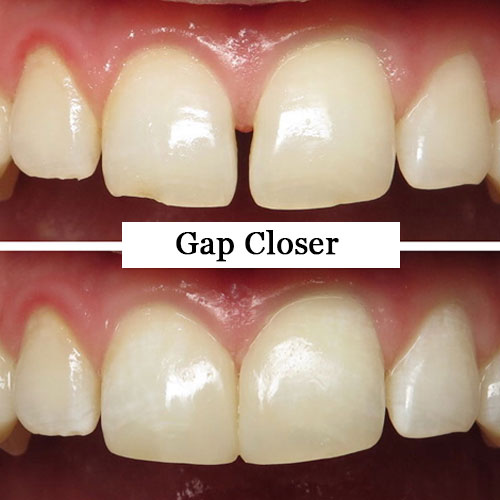-
Appointment Booking
[email protected] -
Call Us Now
+91-11-41627127, +91-9818465668

Generalised gaps in teeth, or a midline gap called as Diastema can occur due to various reasons. Smaller gaps can be eliminated through Direct or Indirect Veneers, Composite or Porcelain veneers or though composite build up. Our cosmetic dentist will help you achieve a beautiful natural looking smile.
What are the common causes of gaps between teeth, and do they always require gap closure?
Gaps between teeth, also known as diastema, can be caused by various factors, including genetics, the size of your teeth, gum tissue positioning, or habits like thumb-sucking. While some people seek gap closure for cosmetic reasons, not all gaps necessarily require treatment. It's essential to consult with a dentist or orthodontist to determine if gap closure is necessary for your specific case. They can evaluate your oral health and discuss your cosmetic concerns to help you make an informed decision.
How is gap closure achieved, and are there different treatment options?
Gap closure can be achieved through several dental procedures. Orthodontic treatment, such as braces or clear aligners, is a common method for closing gaps by gradually moving teeth into their desired positions. Another option is dental bonding, which involves applying tooth-colored resin to fill the gap and reshape the teeth. Additionally, dental veneers or crowns can be used to close large gaps or improve the appearance of teeth with irregular shapes or sizes. The choice of treatment depends on the size and location of the gap, your dental health, and your cosmetic goals.
Is gap closure a lengthy process, and will it be painful?
The duration of gap closure treatment can vary depending on the method chosen and the complexity of the case. Orthodontic treatment can take several months to a few years, while dental bonding or veneers can often be completed in a single visit. The process should not be painful, but some orthodontic discomfort or minor sensitivity may occur, especially when your braces are adjusted. Dental professionals will provide guidance on managing any potential discomfort, and you can expect a more comfortable experience as your treatment progresses.
Are there any risks or complications associated with gap closure procedures?
Gap closure procedures are generally safe when performed by qualified dental professionals. However, there can be risks and complications, such as tooth sensitivity or discomfort during orthodontic treatment, and there may be slight reshaping of the teeth in some cases. Dental bonding and veneers are typically low-risk but can require maintenance over time. It's essential to follow your dentist's post-treatment care instructions to minimize risks and maintain the results.
Will my insurance cover the cost of gap closure?
The coverage for gap closure procedures can vary depending on your dental insurance plan. Orthodontic treatment, when deemed medically necessary, may receive partial coverage. However, cosmetic procedures like dental bonding, veneers, or crown placement are often not covered by insurance. It's important to check with your insurance provider to understand your specific coverage and any out-of-pocket expenses you might incur. Your dental provider can also help you explore financing options if needed.